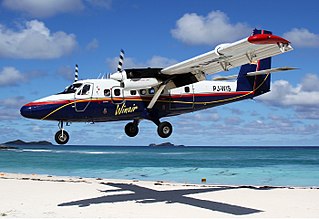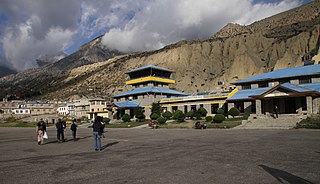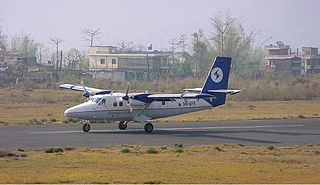
The de Havilland Canada DHC-6 Twin Otter is a Canadian STOL utility aircraft developed by de Havilland Canada in the mid-1960s and still in production today. De Havilland Canada produced it from 1965 to 1988; Viking Air purchased the type certificate, then restarted production in 2008 before re-adopting the DHC name in 2022. In 2023 DHC restarted production of the 300 series, in addition to the Series 400 produced by Viking. The aircraft's fixed tricycle undercarriage, STOL capabilities, twin turboprop engines and high rate of climb have made it a successful commuter airliner, typically seating 18–20 passengers, as well as a cargo and medical evacuation aircraft. In addition, the Twin Otter has been popular with commercial skydiving operations, and is used by the United States Army Parachute Team and the 98th Flying Training Squadron of the United States Air Force.
Nepal Airlines Corporation, formerly known as Royal Nepal Airlines, is the flag carrier of Nepal. Founded in 1958, it is the oldest airline of the country. Out of its main base at Tribhuvan International Airport, Kathmandu, the airline operates domestic services within Nepal and medium-haul services in Asia. The airline's first aircraft was a Douglas DC-3, used to serve domestic routes and a handful of destinations in India. The airline acquired its first jet aircraft, Boeing 727s, in 1972. As of February 2023, the airline operates a fleet of six aircraft. Since 2013, the airline has been on the list of air carriers banned in the European Union.

Yeti Airlines Pvt. Ltd. is an airline based in Kathmandu, Nepal. The airline was established in May 1998 and received its air operator's certificate on 17 August 1998. Since 2019, Yeti Airlines is the first carbon neutral airline in Nepal and South Asia. It is the parent company of Tara Air. As of 2022, Yeti Airlines was the second-largest domestic carrier in Nepal, after Buddha Air.

Tenzing-Hillary Airport, also known as Lukla Airport, is a domestic airport and altiport in the town of Lukla, in Khumbu Pasanglhamu, Solukhumbu District, Koshi Province of Nepal. It gained worldwide fame as it was rated the most dangerous airport in the world for more than 20 years by a program titled Most Extreme Airports, broadcast on The History Channel in 2010.

Jomsom Airport is a domestic airport located in Jomsom serving Mustang District, a district in Gandaki Province in Nepal. It serves as the gateway to Mustang District that includes Jomsom, Kagbeni, Tangbe, and Lo Manthang, and Muktinath temple, which is a popular pilgrimage for Nepalis and Indian pilgrims.

Jumla Airport is a domestic airport located in Jumla serving Jumla District, a district in Karnali Province in Nepal.
Lamidanda Airport is a domestic airport located in Lamidanda, Rawabesi, serving Khotang District, a district in Koshi Province in Nepal. According to the Civil Aviation Authority of Nepal, it is the gateway to the Halesi-Maratika Caves. Status: Not Active

Surkhet Airport, also known as Birendranagar Airport is a domestic airport located in Birendranagar serving Surkhet District, a district in Karnali Province in Nepal. The Civil Aviation Authority of Nepal considers it an important hub for cargo transport into remote Western areas of Nepal, however this role is declining due to increasing road connectivity. Buddha Air has started daily flights to and from Kathmandu since 22 December, 2022 using its ATR-72 aircraft.

Yeti Airlines Flight 101 was a domestic flight in Nepal, that crashed on final approach to Tenzing-Hillary Airport in the town of Lukla in eastern Nepal on 8 October 2008. The De Havilland Canada DHC-6 Twin Otter Series 300 registered as 9N-AFE originated from Tribhuvan International Airport in Kathmandu.

Merpati Nusantara Airlines Flight 9760D was a domestic commercial passenger 50-minutes flight, flying from Sentani Airport in Papua's Province Jayapura to Oksibil Airport in Oksibil, Indonesia operated by a de Havilland Canada DHC-6 Twin Otter 300. On Sunday, August 2, 2009, while carrying fifteen people over Papua, the aircraft went missing en route. Its wreckage was found a few miles from Oksibil two days later. All 12 passengers and 3 crew members were killed in the accident.

Tara Air Pvt. Ltd. is an airline headquartered in Kathmandu, Nepal. It is a subsidiary of Yeti Airlines. Tara Air was formed in 2009 using aircraft from the Yeti Airlines fleet and is based at Tribhuvan International Airport, with a secondary hub at Nepalgunj Airport. The airline operates scheduled flights and air charter services with a fleet of STOL aircraft, previously provided by Yeti Airlines. Its operations focus on serving remote and mountainous airports and airstrips.

Rara Airport, also known as Talcha Airport, is a domestic airport located in Chhayanath Rara serving Rara National Park in Karnali Province in Nepal.

Nepal Airlines Flight 555 was a short domestic scheduled flight from Pokhara Airport to Jomsom Airport in Nepal of about 20 minutes' flying time, operated by Nepal Airlines. On 16 May 2013 the de Havilland Canada DHC-6 Twin Otter aircraft operating the flight crashed while landing at Jomsom Airport. Seven of the twenty-one on board were seriously injured. There were no fatalities, but the aircraft was damaged beyond economic repair.

Nepal Airlines Flight 183 was a scheduled domestic passenger flight operated by a DHC-6 Twin Otter that on 16 February 2014 crashed into a hill near Dhikura, Nepal.

Tara Air Flight 193 was a scheduled domestic passenger flight from Pokhara to Jomsom, Nepal. On 24 February 2016, eight minutes after take-off, the aircraft serving the flight, a Viking Air DHC-6-400 Twin Otter went missing with 23 people on board. Hours later, the wreckage was found near the village of Dana, Myagdi District. There were no survivors. It was Tara Air's deadliest accident.

On 27 May 2017, a Let L-410 Turbolet operating as Summit Air Flight 409 crashed short of the runway whilst attempting to land at Tenzing–Hillary Airport in Nepal. It was on final approach when the aircraft hit trees short of the runway and subsequently slid down a slope before coming to rest about 200 metres (656 ft) below runway level and 40 metres (131 ft) short of the runway. The captain and the first officer died as a result of the accident, while another crew member received injuries.

On 22 August 2002, a Shangri-La Air DHC-6 Twin Otter crashed against a hill 5 kilometers south-east of Pokhara, which was completely clouded following three days of continuous rains.

On 27 July 2000, de Havilland Canada DHC-6 Twin Otter operated by Royal Nepal Airlines crashed in Nepal en route from Bajhang Airport to Dhangadhi Airport on a domestic passenger flight. The wreckage of the aircraft, registration 9N-ABP, was found in Jogbuda, Dadeldhura District. All 22 passengers and the three crew aboard were killed in the crash. An investigation into the crash was launched by Nepalese authorities after the accident site was located.

On 1 August 1962, a Douglas DC-3 operated by Royal Nepal Airlines crashed in Nepal en route from Gaucher Airport to Palam Airport on an international scheduled passenger flight. The wreckage of the aircraft, registration 9N-AAP, was found near Tulachan Dhuri. All 10 passengers and four crew aboard were killed in the crash. An investigation into the crash was launched by Nepalese authorities after the accident site was located. It was the first aviation accident of an international flight by a Nepali carrier.

Tara Air Flight 197 was a scheduled domestic flight operated by Tara Air for parent company Yeti Airlines from Pokhara Airport to Jomsom Airport in Nepal. On 29 May 2022, the Twin Otter aircraft carrying 22 people departed at 09:55 NPT and lost contact with air traffic controllers about 12 minutes later at 10:07 (04:22). The wreckage was located 20 hours later on a mountainside. All 22 passengers and crew were killed, and all 22 bodies were recovered. This was Tara Air's second deadly accident on this route, after Flight 193 in 2016.



















